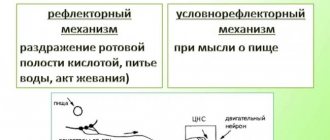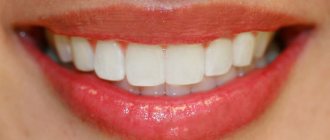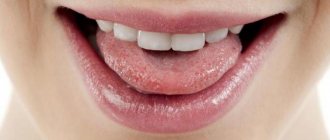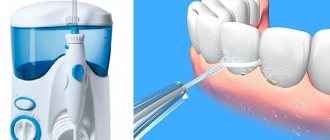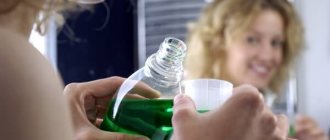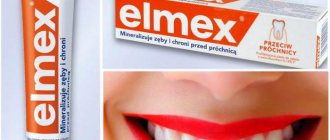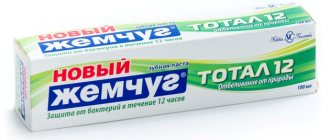We swallow saliva regularly. And we are accustomed to the fact that the oral cavity is always wet and we perceive the cessation of sufficient production of this biological fluid with suspicion. As a rule, increased dry mouth is a sign of some disease.
Saliva is a common and necessary biologically active liquid. Helps maintain the level of immune defense in the oral cavity and digestion of food. What is the composition of human saliva, fluid production rates, as well as physical and chemical properties?
A little biology
Saliva is a biological substance secreted by the salivary glands. Liquid is produced by 6 large glands - submandibular, parotid, sublingual - and many small ones located in the oral cavity. Up to 2.5 liters of fluid are released per day.
The composition of the secretions of the salivary glands differs from the composition of the fluid in the oral cavity. This is due to the presence of food debris and the presence of microorganisms.
Functions of biological fluid:
- wetting the food bolus;
- disinfectant;
- protective;
- promotes articulation and swallowing of food bolus;
- breakdown of carbohydrates in the oral cavity;
- transport - the liquid wets the epithelium of the oral cavity and participates in the exchange of substances between saliva and the oral mucosa.
Mechanism of saliva production
From ulcers to infections
An experienced doctor can judge the condition and functioning of certain organs by the nature of saliva, as well as identify certain diseases at an early stage. Thus, during infectious diseases, the slightly alkaline reaction of saliva changes to acidic. With nephritis (inflammation of the kidneys), the amount of nitrogen in saliva increases, the same thing happens with peptic ulcers of the stomach and duodenum. With diseases of the thyroid gland, saliva becomes viscous and foamy. The composition of saliva also changes in some tumors, which makes it possible to detect the disease or confirm the diagnosis when the clinical picture is not yet obvious.
Article on the topic
Come on, breathe! What causes bad breath
As the body ages, the proportions of micro- and macroelements in saliva are disrupted, which leads to the deposition of tartar, increasing the likelihood of caries and inflammatory periodontal diseases.
There is a change in the composition of saliva during fasting, as well as with certain hormonal imbalances.
So don’t be surprised if your doctor orders a saliva test—you can really learn a lot from it.
Taste of illness. How to determine your diagnosis by the taste in your mouth
More details
Physical properties and composition of saliva
Biological fluid in a healthy person has a number of physical and chemical properties. They are presented in the table.
Table 1. Normal characteristics of saliva.
| Index | Characteristic |
| Transparency | Transparent, minor inclusions of air, pieces of food. |
| Density | Slightly higher than the density of water, depending on the composition - from 1 to 1.12 g/ml. |
| Color | Normally – absent. |
| Viscosity | Insignificant and unstable, depends on the current state of the body. |
| Taste | Absent. |
| pH | Alkaline – 7.4–8.0. |
The main component of oral fluid is water – up to 98%. The remaining components can be roughly divided into acids, minerals, trace elements, enzymes, metal compounds, and organics.
Saliva is normal
The salivary glands of a healthy adult produce from one to two liters of secretion every day. The purpose of this liquid is to lubricate the oral cavity to facilitate chewing and speaking. Thanks to the secretion, the digestion of food begins at the moment of chewing it, since saliva contains active enzymes. The perception of the taste of foods also depends on the degree of their processing by salivary fluid.
Saliva is the first most accessible natural antiseptic. This is why small wounds in the mouth heal much faster than on the skin.
In order for all these processes to proceed exactly as needed, salivation must be sufficient, and the discharge itself must be transparent or slightly cloudy, liquid and imperceptible to humans. A violation of the usual consistency of saliva cannot be ignored, as an obsessive feeling of discomfort is created, speech and the usual rhythm of life are disrupted, and problems with digestion, teeth and oral mucous membranes are possible.
Subtleties of saliva secretion
0.5 ml of saliva per minute should be produced in a healthy person during the daytime
The work of the salivary glands is controlled by the autonomic nervous system, centered in the medulla oblongata. Salivary fluid production varies depending on the time of day. At night and during sleep, its amount decreases sharply and increases during the day. In a state of anesthesia, the work of the glands completely stops.
During wakefulness, 0.5 ml of saliva is secreted per minute. If the glands are stimulated - for example, during a meal - they produce up to 2.3 ml of liquid secretion.
The composition of the secretion of each gland is different. When it enters the oral cavity, mixing occurs, and it is called “oral fluid.” Unlike the sterile secretion of the salivary glands, it contains beneficial and opportunistic microflora, metabolic products, desquamated epithelium of the oral cavity, discharge from the maxillary sinuses, sputum, red and white blood cells.
pH values are influenced by compliance with hygiene requirements and the nature of food. So, when stimulating the work of the glands, the indicators shift to the alkaline side, and with a lack of fluid - to the acidic side.
In various pathological processes, there is a decrease or increase in the secretion of oral fluid. Thus, with stomatitis, neuralgia of the branches of the trigeminal nerve, and various bacterial diseases, overproduction is observed. With inflammatory processes in the respiratory system and diabetes mellitus, the secretion production of the salivary glands decreases.
Thesiography - diagnostics of saliva. Saliva and its effect on oral health
What is the pH of saliva?
This is a pH value that helps determine the acidity of oral fluid.
Determination of the pH of saliva is carried out with special test paper strips soaked in acid and an acid-base indicator. A drop of saliva from a pipette is applied to such a strip; the saliva, to one degree or another, neutralizes the acidic impregnation of the strip, as evidenced by a change in the color of the indicator. Most often, the initial acidic pH level = 4.5 corresponds to a yellow-brown color, slightly acidic pH = 4.5-5.5 - green color, neutral pH - blue color. The closer the strip gets to the neutral state under the influence of buffer forces, the better.
The role of Ph in the development of caries
The reflux of acidic stomach contents through the esophagus into the oral cavity helps reduce the pH of saliva and plays an active role in the development of “local” pathological processes. After the hydrochloric acid has reached its destination, the Ph of the mixed saliva decreases to 7.
The secretion, which normally has alkaline properties, with an acidity level of 6–6.2 causes the destruction of tooth enamel, its demineralization, which subsequently results in the appearance of carious lesions. The gums become inflamed, swollen, red, and the amount of mucus on the mucous membrane increases noticeably. Oxygen-rich saliva prevents the proliferation of pathogenic microflora; with reduced acidity, these microorganisms “bloom.” Hunger, excitement, stress, pronouncing a long monologue, breathing through the mouth - these are all the factors that lead to a decrease in Ph. The same phenomenon is associated with natural age-related changes in the body.
The pH of mixed saliva allows us to judge the degree of demineralization of free dental tissues. This biological fluid constantly maintains a neutral acid-base reaction (average value - 7.2) of the oral environment due to the proteins and phosphates it contains.
According to the results of modern research, it is the prolonged exposure of acids to the hard tissues of teeth that provokes the appearance of carious lesions. When acidity decreases, saliva retains and binds calcium atoms, which leads to demineralization of teeth. Biological fluid prevents the dissolution of enamel and ensures the diffusion of calcium and phosphorus ions.
Saliva and its effect on oral health
It should be noted that the development of caries is associated not only with teeth and the activity of bacteria. The oral cavity represents
is a complex of organs and tissues in a moist environment (saliva). Saliva is a complex secretion. Oral fluid is commonly referred to as "mixed saliva." It primarily consists of the secretions of the major and minor salivary glands. In addition, it contains a number of components of non-salivary origin. These include: fluid of the gingival groove, serum components and blood cells, bacteria and their metabolic products, desquamated epithelium and cellular components, viruses and fungi, food debris and sputum secreted from the bronchi. Saliva is 99% water. The remaining 1% consists of large molecules of organic compounds such as proteins, glycoproteins and lipids, as well as small molecules of organic substances such as glucose and urea, electrolytes, mainly sodium, calcium, chloride and phosphates.
Mixed saliva is complete saliva without impurities that can be removed by centrifugation, or a mixture of pure saliva from all sources. Pure saliva is a liquid produced and secreted into the oral cavity by three pairs of large and many small glands. Every day, from 300 to 1500 ml of saliva is secreted into the human oral cavity. The production of saliva during the day is uneven: within 14 hours, without eating, approximately 300 ml of the so-called basic, unstimulated saliva is produced (salivation rate - 0.25-0.50 ml/min), within 2 hours, 200 ml is released against the background of food stimulated saliva (at a rate of 2.0 ml/min), and in the remaining time - 8 hours of night sleep - salivation practically stops (0.1 ml/min). At any given time, there is about 0.5 ml of saliva in the oral cavity. The prevalence and intensity of caries depend on the rate of salivation; these indicators are higher in children with a sharp decrease in salivation.
Saliva is well known to have protective properties against dental caries. The most direct evidence of this fact is the development of “blooming” caries following the cessation of the functioning of the salivary glands due to irradiation with high doses, due to tumors of the head and neck. Such caries is so destructive that within a few weeks it affects usually caries-resistant surfaces and causes complete destruction of the crowns of the teeth.
The main properties of saliva that provide protection against caries are the following:
- dilution and clearance of food sugars; • neutralization and buffering of acids in dental plaque; • providing ions for the remineralization process.
- lysozyme - can destroy the cell wall and dissolve bacteria; • lactoferrin - connects iron atoms to bacterial cells, which gives a bacteriostatic effect; • lactoperoxidase group - thiocyanin - H2 + O2 - the formation of oxygen springs gives a bactericidal effect, these sources accompany the reaction of many unsaturated fatty acids in the cell wall of the bacterium.
Saliva has a significant effect on the pH level of dental plaque, including preparing the food bolus for swallowing, as a result of which mechanical and chemical cleaning of the oral cavity occurs, and food debris that adheres to the smooth surface of the tooth is eliminated.
At the same time, they are partially purified enzymatically. Both of these processes are essential for the prevention of caries. Saliva protects the mucous membrane from damage, and also protects teeth from pathological abrasion by antagonist teeth. The enamel-saliva system can easily withstand a short-term “attack” of acid on the teeth.
Fluorine, phosphates and calcium found in saliva are the initiators of remineralization. The buffer system can neutralize acids to some level. In the moist environment of the oral cavity, acidic bacterial products cause constant pH fluctuations, which are neutralized by the buffer system. The buffer system is a protective element of saliva. Direct release of substances that inactivate bacteria:
The concentration of calcium and phosphates in saliva is very significant for the integrity of teeth.
Saliva is saturated with a solution of these ions. Inhibitory substances, similar to some bodies containing phosphates, block the spontaneous precipitation of the salt mixture on the surface of the enamel, which weakens the connection of microorganisms with the tooth surface. On the other hand, the solubility of mineral substances decreases. The reason for the restoration of superficial carious defects is not a single deposition of ions from saliva, but rather the recipitation of dissolved mineral substances removed from the deeper layers of the carious defect. The frequency of fluoride use plays an important role. Mineralizing potential of saliva
The mineralizing potential of oral fluid can be judged by the type of crystal-like formations in a drop of saliva placed on a glass slide. By the type of microcrystallization of saliva, one can judge the patient’s susceptibility to caries. Microcrystallization of saliva has individual characteristics and this may be associated with the general condition of the body, oral cavity, and nutrient load. The formation of microcrystals can characterize the remineralizing ability of saliva, and the intensity of caries is associated with the type of microcrystallization. In caries-resistant individuals, tree-shaped crystal-like formations are observed with a tendency for a drop of saliva to be located in the center.
In those susceptible to caries, this structure changes or disappears completely. It is believed that there is a close relationship between the structural and mineralizing properties of saliva.
There are three types:
Type I - a clear pattern of elongated crystalloprismatic structures fused together and occupying the entire surface of the drop. This type is inherent in the compensated form of caries.
Type II - in the center of the drop, individual dendritic crystalloprismatic structures of smaller sizes are visible than in type I. Characteristic of the subcompensated form of caries.
Type III - a large number of isometrically located crystalline structures of irregular shape are visible throughout the drop. This type of microcrystallization is characteristic of the decompensated form of caries.
At the same time, microcrystallization of saliva reflects the state of the body as a whole, so this parameter can be used for rapid diagnosis of some somatic diseases.
Conclusion
In the structure of dental morbidity, dental caries occupies one of the leading places, which in the absence of timely and correct diagnosis, which in addition to the main examination methods, additional ones should be used (such as test-measurement of saliva pH and thesiography). It is impossible to prescribe adequate treatment, which in turn will lead to the threat of the development of various odontogenic complications, the appearance of foci of chronic infection, functional disorders of the dental system, which have a negative impact on the patient’s health as a whole. Therefore, all efforts of specialists should be aimed at preventing dental caries using the latest technologies and materials available on the global dental market.
In our Jasmine family clinic, you can conduct a saliva pH test and tesiography (determining the mineralizing potential of saliva), where the doctor will tell you in detail about the health of your oral cavity and select an individual course of prevention.
White saliva
Thrush in the mouth
The cause of the appearance of thick white saliva should be sought in fungal infections of the oral cavity and nasopharynx. Most often, this pathology is observed with candidiasis, known as stomatitis or thrush. It usually develops in children, but sometimes appears in adults.
The salivary fluid is colored white by deposits in the form of a cheesy coating characteristic of this infection, which cover the mucous membranes of the mouth. To get rid of the disease, local and internal antifungal drugs are used to strengthen the immune system.
Causes of sticky saliva in the throat
Saliva can not only foam, but also seem to get stuck in the throat. In this case, it is necessary to examine an ENT doctor for damage to the tonsils and larynx. Purulent forms of tonsillitis or tonsillitis are accompanied by the appearance of plaques on the tonsils, which create discomfort and pain, and when opened, they release purulent contents into the pharynx, increasing the saturation of sputum.
Gum disease accompanied by the discharge of pus may also be an explanation for why saliva has become thick, viscous and felt in the throat. Such diseases include periodontitis, periodontal disease, cysts, cellulitis and abscesses. Sticky pus from the affected areas of the gums mixes with saliva and makes swallowing difficult.
How to relieve the condition when saliva is viscous and stringy
A person whose saliva thickens and foams experiences a lot of unpleasant sensations. In addition to discomfort, outbreaks of diseases of the throat, tongue, and gums may become more frequent, and teeth become more vulnerable to caries. Therefore, this symptom must be eliminated using conservative and traditional methods of treatment.
Having determined why the saliva in the patient’s mouth has become thick and viscous, the doctor will prescribe treatment for the underlying disease that caused xerostomia, as well as auxiliary local methods that will help quickly return to normal life:
- artificial saliva;
- various oral moisturizers in an easy-to-use form (gel or spray);
- specialized rinses;
- special chewing gum and lollipops;
- drinking plenty of fluids.
Folk remedies for the treatment of xerostomia include sage or fenugreek tea, lubrication of the oral cavity with a mixture of peach oil and propolis, and inhalations with eucalyptus. But it is better to discuss these treatment methods with your doctor.
It would not be superfluous to purchase an air humidifier for the room and give up tobacco, alcohol, soda and coffee, which additionally dehydrate the mucous membranes. The consumption of dairy products will also have to be minimized. The daily volume of clean water consumption should be at least one and a half liters. During this period, it is better to choose a toothbrush with soft bristles so as not to injure dehydrated gum tissue.
Don't wait until unusual sensations in your mouth develop into unbearable ones. The viscosity of saliva is one of the serious indicators of the health of the body. If it deviates from the norm, action must be taken.
What should you be wary of?
Typically, patients' complaints are related to the fact that in the morning their saliva is not as usual: thick, sticky or foamy. In such cases, accompanying symptoms may occur:
- violation of taste perception;
- constant dry mouth and throat;
- feeling of persistent thirst;
- tingling sensation on the tongue;
- difficulty and pain when chewing and swallowing food;
- sore throat and hoarseness;
- cracks on the lips;
- rapid formation of plaque on teeth;
- inflammatory processes in the oral cavity and gums.
All these phenomena may be a consequence of changes in the composition, quantity and viscosity of saliva. A simple test that you can take yourself in the morning on an empty stomach will help you verify the validity of such suspicions or dispel them. To do this, you need to get a pipette with marked divisions and a stopwatch.
First, you need to put a milliliter of ordinary water into a pipette and observe how long it takes for it to flow out. Then you need to do the same with the salivary fluid. It remains to compare the two indicators - normally, they should be approximately the same.
But self-examination is a subjective thing, therefore, if there is any suspicion of a serious malfunction in the body, you should contact specialists to conduct accurate laboratory tests. Doctors determine whether the consistency of saliva is normal using a viscometer. If he confirms that the patient really has too thick saliva in his mouth, the doctor will determine the cause of the defect and prescribe the necessary treatment. Diagnosis will require additional tests and consultations with specialists, so self-medication in such a situation is unacceptable.
Why does caries develop?
Scientists are still studying the mechanisms of the development of caries - one of the most common diseases on the planet. They agree that caries is caused by microorganisms living in the oral cavity, in the presence of associated factors. These factors include carbohydrate nutrition, poor oral hygiene, and the qualitative and quantitative composition of saliva.
How does the carious process develop and why do cavities form in teeth? Contrary to popular belief, microbes do not chew holes in teeth; caries develops differently. Cariogenic bacteria (one of the species is Streptococcus mutans) form colonies on the surface of teeth, collecting in a biofilm - dental plaque. These bacteria “love” foods rich in carbohydrates and ferment the sugars contained in them. The products of carbohydrate processing by bacteria are organic acids. So they harm our teeth and contribute to the development of caries.
Acids produced by bacteria disrupt the normal structure of the enamel, promote its demineralization, penetrate into the deep tissues of the tooth and continue to destroy it from the inside. The more microbes in the mouth, the more carbohydrates they receive, the higher the acidity on the surface of the teeth and the more active the process of their destruction occurs.
Prevention
To avoid problems such as increased viscosity of saliva, it is recommended to drink at least 2 liters of liquid per day, with preference given to purified water. It is better to limit the intake of carbonated, caffeinated drinks (they dehydrate the body). Quitting alcoholic beverages and smoking also has a beneficial effect on the functioning of the salivary glands.
Important! Excessive consumption of cheese and milk causes additional mucus production; it is recommended to reduce the amount of these products in the diet.
It is useful to rinse your mouth with a warm saline solution from time to time, avoid hypothermia and stress, do not buy sugar-containing chewing gum, and humidify the air in the room. A well-structured, balanced diet with plenty of fiber (vegetables, fruits) and cereals is the best prevention of any problems with the digestive organs, including the salivary glands.
So, foamy, sticky and viscous saliva is a signal notifying about certain problems in the body. The cause of the anomaly may lie in a malfunction of the salivary glands themselves, hormonal or metabolic disorders, bad habits or chronic diseases (“the respiratory organs, gastrointestinal tract, and oral cavity suffer”). A dentist will help determine the cause of the problem and select the appropriate treatment, who, if necessary, will involve other specialists (immunologist, neurologist, gastroenterologist, etc.).
